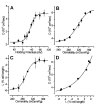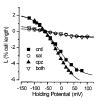Voltage- and tension-dependent lipid mobility in the outer hair cell plasma membrane
- PMID: 10650000
- PMCID: PMC1976274
- DOI: 10.1126/science.287.5453.658
Voltage- and tension-dependent lipid mobility in the outer hair cell plasma membrane
Abstract
The mechanism responsible for electromotility of outer hair cells in the ear is unknown but is thought to reside within the plasma membrane. Lipid lateral diffusion in the outer hair cell plasma membrane is a sigmoidal function of transmembrane potential and bathing media osmolality. Cell depolarization or hyposmotic challenge shorten the cell and reduce membrane fluidity by half. Changing the membrane tension with amphipathic drugs results in similar reductions. These dynamic changes in membrane fluidity represent the modulation of membrane tension by lipid-protein interactions. The voltage dependence may be associated with the force-generating motors that contribute to the exquisite sensitivity of mammalian hearing.
Figures




Similar articles
-
Amphipath-induced nanoscale changes in outer hair cell plasma membrane curvature.Biophys J. 2009 Jan;96(2):510-20. doi: 10.1016/j.bpj.2008.09.016. Biophys J. 2009. PMID: 19167301 Free PMC article.
-
Lipid lateral mobility in cochlear outer hair cells: regional differences and regulation by cholesterol.J Assoc Res Otolaryngol. 2009 Sep;10(3):383-96. doi: 10.1007/s10162-009-0171-1. Epub 2009 Jun 11. J Assoc Res Otolaryngol. 2009. PMID: 19517190 Free PMC article.
-
Chlorpromazine alters outer hair cell electromotility.Otolaryngol Head Neck Surg. 2001 Jul;125(1):71-6. doi: 10.1067/mhn.2001.116446. Otolaryngol Head Neck Surg. 2001. PMID: 11458218
-
Regulation of electromotility in the cochlear outer hair cell.J Physiol. 2006 Oct 1;576(Pt 1):43-8. doi: 10.1113/jphysiol.2006.114975. Epub 2006 Aug 3. J Physiol. 2006. PMID: 16887876 Free PMC article. Review.
-
Nanotechnology in Auditory Research: Membrane Electromechanics in Hearing.Methods Mol Biol. 2016;1427:349-62. doi: 10.1007/978-1-4939-3615-1_20. Methods Mol Biol. 2016. PMID: 27259937 Free PMC article. Review.
Cited by
-
Microdomains shift and rotate in the lateral wall of cochlear outer hair cells.Biophys J. 2013 Jan 8;104(1):8-18. doi: 10.1016/j.bpj.2012.11.3828. Epub 2013 Jan 8. Biophys J. 2013. PMID: 23332054 Free PMC article.
-
Functional prestin transduction of immature outer hair cells from normal and prestin-null mice.J Assoc Res Otolaryngol. 2008 Sep;9(3):307-20. doi: 10.1007/s10162-008-0121-3. Epub 2008 May 28. J Assoc Res Otolaryngol. 2008. PMID: 18506528 Free PMC article.
-
Mechanosensitivity of Nav1.5, a voltage-sensitive sodium channel.J Physiol. 2010 Dec 15;588(Pt 24):4969-85. doi: 10.1113/jphysiol.2010.199034. Epub 2010 Nov 1. J Physiol. 2010. PMID: 21041530 Free PMC article.
-
Excitation of fluorescent dyes inactivates the outer hair cell integral membrane motor protein prestin and betrays its lateral mobility.Pflugers Arch. 2003 Aug;446(5):617-22. doi: 10.1007/s00424-003-1053-8. Epub 2003 May 29. Pflugers Arch. 2003. PMID: 12783229
-
Amphipath-induced nanoscale changes in outer hair cell plasma membrane curvature.Biophys J. 2009 Jan;96(2):510-20. doi: 10.1016/j.bpj.2008.09.016. Biophys J. 2009. PMID: 19167301 Free PMC article.
References
-
- Brownell WE, Bader CR, Bertrand D, de Ribaupierre Y. Science. 1985;227:194. - PubMed
-
- Vaz WLC, Derzko ZI, Jacobson KA. In: Membrane Reconstitution. Poste G, Nicolson GL, editors. Elsevier; Amsterdam: 1982. pp. 83–136.
-
- Golan DE, Alecio MR, Veatch WR, Rando RR. Biochemistry. 1984;23:332. - PubMed
-
-
The organ of Corti was isolated from the cochleae of guinea pigs, incubated for 3 to 5 min with trypsin, and dissociated onto a microwell petri dish. For some experiments, rat hippocampal neurons were used as a control. These cells were harvested on embryonic day 19 and grown in culture for 9 to 12 days in serum-free medium. Dissection and experiments were performed at 22°C in an extracellular solution consisting of the following: 155 mM NaCl, 4 mM KCl, 1 mM MgCl2, 2 mM CaCl2, 10 mM Hepes, and 10 mM glucose. The solution was adjusted to a pH of 7.3 and an osmolality of 320 mOsm/kg. We stained the plasma membrane of the isolated cells with di-8-ANEPPS, a fluorescent molecule with a short hydrophobic tail that inserts itself into the outer leaflet of the phospholipid bilayer. Di-8-ANEPPS (75 μM) was dispersed into extracellular solution by sonication for 1 min, and the cells were stained for 5 min before unbound dye was thoroughly rinsed away with extracellular solution alone Montana V, Farkas DL, Loew LM. Biochemistry. 1989;28:4536.Oghalai JS, Tran TD, Raphael RM, Nakagawa T, Brownell WE. Hear Res. 1999;135:19.
-
Publication types
MeSH terms
Substances
Grants and funding
LinkOut - more resources
Full Text Sources

